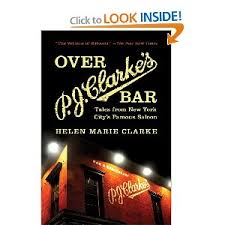In the book Over P.J. Clarke’s Bar: Tales from New York City’s Famous Saloon by Helen Marie Clarke, you get just that. Written in a conversational tone with an eye for history and the impact on family through the lens, or behind the bar of one of the oldest continuously running bar in New York, Clarke has spun an ancestral yarn on an establishment that has witnessed, within the fray, New York’s history from 1884 to the present.
Mrs. Clarke, who is the grandniece of Patrick “Paddy” Clarke, who took over the saloon in 1912, calmly describes how times changed around the old saloon on 3rd Avenue and 55th Street as if she’s waiting for your Guinness to settle. With the gentle nature of an Irish storyteller, she hands you the ugly truths and the good ol’ times in the same sweet tone.
The saloon originally opened in 1884. Paddy Clarke emigrated from County Leitrim, Ireland in 1902 and eventually saved up enough money (possibly with the help of a beer sponsor) and opened as P.J. Clarke’s in 1912.
Paddy was a typical Irish immigrant of the era and believed sincerely in Irish freedom back home. He hung photos of Ireland’s dead patriots on his walls alongside Abraham Lincoln in a time when Ireland was still under the thumb of the British Empire. Mrs. Clarke goes on to explain conversations she had with Paddy when she was a child and speaks with a tone of pride how he hung a picture of Ireland’s Proclamation of Independence from the 1916 Easter Rising.
These are the seeds of the traditional New York City Irish pub. The seeds that we so often forget about and the seeds that so many of the young have never heard about. Mrs. Clarke does a great service to describe her grand uncle’s connection to the old country. She also describes how her father and uncles had a very hard time talking about Ireland. Another very important trait of the immigrant Irish as the history of Ireland and its people was seen and felt as the greatest of tragedies. From hundreds of years of oppression, forced emigration and starvation, in her grand uncle’s and her father’s generation, it was just too emotional to speak of.
My own great-grandfather owned a similar saloon on Hudson Street in Greenwich Village on the other side of Manhattan. It opened in 1906 and was also a supporter of Irish freedom. So, as Mrs. Clarke reminisces about Paddy’s pride in Irish freedom, it brings this reader back to the stories told in my own childhood of the Irish in New York.
Throughout the history of New York, from two world wars, the Great Depression, the unrest of the 1960s, the city’s recession in the 1970s, PJ Clarke’s stood strong and served up good times.
Famous visitors regularly have come to PJ Clarke’s, from Rocky Marciano, to Jacqueline Kennedy, Richard Harris, Frank Sinatra, Marilyn Monroe toErnest Borgnine and, according to some recent reading of my own, Malachy McCourt (A Monk Swimming) was a famous drinker at PJ Clarke’s as well.
Today, there is some angst toward the treatment of women in the New York saloons of the old days. And it was true that most women and girls were not allowed inside them. And if they were, they were required to enter through a back entrance. Mrs. Clarke, realizing this treatment, describes the reasons.

Richard Harris (left), one of my favorite actors, once said, “We walked into P.J. Clarke’s, I said, ‘Vinny, my usual.’ And he lined up six double vodkas.”
“Uncle Paddy’s ‘no women at the bar’ was simply reflective of the culture at the time.”
Since women almost never walked the streets of New York without a male accompanying her, walking into a saloon was just not traditionally acceptable at the time. Mostly because women who did actually patron saloons were prostitutes, as some New York establishments had back rooms and upstairs accommodations for sexual transactions, which the house benefited. In truth, most New Yorkers would have seen a woman sitting in PJ Clarke’s as a “lady of the night.”
However, Mrs. Clarke always had access to it from the time she was a young child. Her father and brothers, in New York fashion, lived above the bar with their uncle Paddy for many years.But Mrs. Clarke’s tone becomes sorrowful when she mentions that PJ Clarke’s had a policy of ‘no women’ longer than most other New York bars. And in the 1960s, PJ Clarke’s was visited by feminists and protestors that forced it to change.
Through good times and bad, PJ Clarke’s has stood. And oh by the  way, if you happen to be in the city, come by for a drink.
way, if you happen to be in the city, come by for a drink.
It’s still open, 915 Third Avenue.
Eamon Loingsigh’s historical novel "Light of the Diddicoy" about the Brooklyn-Irish White Hand Gang (Three Rooms Press) is due for publication St. Patrick’s Day, 2014.

You need to be a member of The Wild Geese to add comments!
Join The Wild Geese